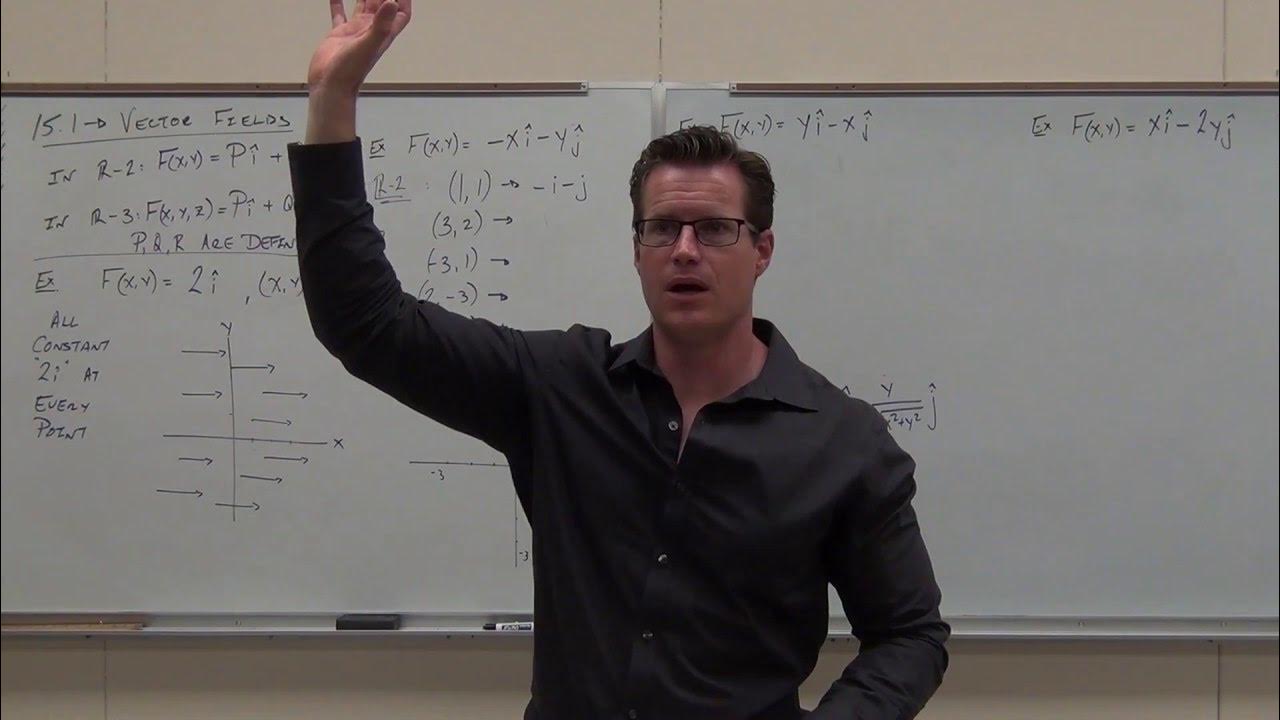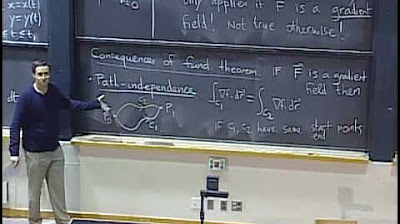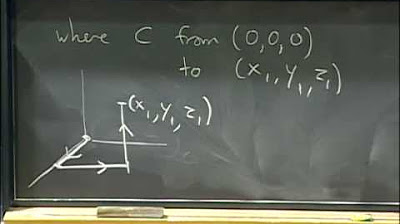Calculus 3: Lecture 15.1 Vector Fields
TLDRThe video script is a detailed lecture on vector fields, specifically focusing on conservative vector fields in a plane region. It explains the concept of a vector field as a function that assigns a vector to each point in a plane, using examples like the gradient vector, velocity fields, and water flow in pipes to illustrate physical interpretations. The lecturer then discusses the mathematical definition of conservative vector fields, relating them to the conservation of energy in physics, and provides a test for determining if a vector field is conservative. The script includes several examples and problems to demonstrate how to find potential functions for conservative vector fields, emphasizing the importance of understanding these concepts for students in physics and engineering.
Takeaways
- 📚 A vector field is a function over a plane region that assigns a vector to each point (x, y) in the region.
- 🌐 The gradient of a scalar function is an example of a vector field, representing the direction of maximum increase.
- 🔄 Velocity fields are another type of vector field, often used in physics to describe the motion of particles or fluid flow.
- 🔄🌀 An example of a velocity field is the flow of water through a pipe, where the velocity vectors are larger in the center, indicating faster flow.
- 🔍 A conservative vector field is one that is the gradient of some differentiable function, which is related to the conservation of energy in physics.
- 📘 To determine if a vector field is conservative, one must check if the partial derivatives of its components satisfy the condition ∂M/∂y = ∂N/∂x.
- 🔑 The potential function, associated with a conservative vector field, is found by integrating the components of the field with respect to their respective variables.
- 📝 The process of finding the potential function involves integrating each component of the vector field and setting them equal to each other, accounting for constants of integration.
- 🔢 The script provides examples of how to work with vector fields, including determining if they are conservative and finding their potential functions, with an emphasis on mathematical procedures.
- 🎓 The explanation is tailored for students in fields like physics or engineering, who are likely to encounter vector fields in their studies.
- 📑 The script also discusses the concept of exact differential equations, which are related to conservative vector fields and involve integrating each term with respect to its variable.
Q & A
What is a vector field?
-A vector field over a plane region R is a function that assigns a vector to each point (x, y) in R. It can be visualized as an array of vectors with different magnitudes and directions over a plane.
What is an example of a vector field?
-One example of a vector field is the gradient of a scalar function, which points in the direction of maximum increase at each point in the field.
How is the gradient vector related to potential energy?
-The gradient vector can be thought of as pointing in the direction of steepest ascent on a potential energy surface, indicating the direction to climb as fast as possible.
What is a velocity field?
-A velocity field is a type of vector field that represents the velocity of a moving fluid at different points in space, often depicted by arrows showing direction and speed.
How do velocity vectors in a rotating system differ with distance from the axis of rotation?
-In a rotating system, the velocity vectors are larger at the outer edges compared to those near the axis of rotation, indicating faster movement at greater distances from the center.
What is a conservative vector field?
-A conservative vector field is one that is the gradient of some differentiable function, meaning it satisfies the condition of conservation of energy in physics.
What is the mathematical condition for a vector field to be conservative?
-A vector field is conservative if there exists a differentiable function such that the vector field components satisfy the condition ∂M/∂x = ∂N/∂y and ∂M/∂y = -∂N/∂x.
What is the significance of finding the potential function of a conservative vector field?
-The potential function, often related to potential energy, can be found by integrating the components of the conservative vector field, providing a scalar representation of the field.
How do you determine if a given vector field is conservative using the test for conservative vector fields?
-To determine if a vector field is conservative, you must check if the partial derivatives of the field's components satisfy the condition mentioned above. If they do, the field is conservative.
What is the process of finding the potential function of a conservative vector field?
-To find the potential function, integrate each component of the vector field with respect to its corresponding variable, adding an arbitrary function of the other variable during integration, and then equate the results.
Can a non-conservative vector field have a potential function?
-No, a non-conservative vector field does not have a potential function because the concept of potential function is only applicable to conservative vector fields.
Outlines
📚 Introduction to Vector Fields
The script begins with an introduction to vector fields, explaining that they are functions over a plane region R that assign a vector to each point (X, Y). The concept is illustrated with examples, including the gradient vector field, which represents the direction of maximum increase on a surface, and velocity fields, which are likened to water flowing through a pipe or objects rotating around an axis. The importance of understanding vector fields for students in physics and engineering is emphasized.
🌀 Examples of Vector Fields in Physics
This paragraph delves into specific examples of vector fields encountered in physics, such as the velocity field around a rotating object, where vectors indicate the speed and direction of rotation at different points. It also discusses the velocity field of water flowing through a pipe, where the water in the center moves faster than at the edges, illustrating the concept with a diagram and explaining the physical interpretation of the vectors.
🔍 The Concept of Conservative Vector Fields
The script introduces the concept of conservative vector fields, which are associated with the conservation of energy in physics. A vector field is considered conservative if it is the gradient of a differentiable function. The mathematical definition is provided, and the importance of this concept in physics, such as in gravitational and electric force fields, is discussed.
📘 Test for Conservative Vector Fields
The paragraph explains the test for determining if a vector field is conservative. It involves checking if the partial derivatives of the vector field's components satisfy certain conditions. The explanation includes the mathematical notation and the conditions for a function to be considered conservative, setting the stage for the application of this test in problem-solving.
📝 Practice Problems on Conservative Vector Fields
The script presents practice problems related to conservative vector fields, guiding the audience through the process of determining if a given vector field is conservative and, if so, finding its potential function. The method involves comparing partial derivatives and integrating to find the potential function, with an emphasis on understanding the process for successful application.
🧩 Integrating to Find Potential Functions
This section focuses on the technique of integrating components of a vector field to find the potential function. The process is explained step by step, with attention to the importance of integrating with respect to the correct variable and accounting for unknown functions of the other variable. The explanation aims to clarify a common point of confusion and ensure that the audience can apply this method accurately.
🔄 Exact Differential Equations and Potential Functions
The script discusses the relationship between exact differential equations and potential functions. It explains that when a vector field is conservative and can be written as an exact differential equation, the process of finding the potential function involves integrating each component with respect to the appropriate variable. The summary highlights the connection between mathematical concepts and their physical interpretations.
📉 Conservative Vector Fields and Their Applications
The final paragraph wraps up the discussion on conservative vector fields, emphasizing their applications in various fields, particularly for students of engineering who will encounter these concepts in fluid dynamics and other courses. The script hints at the complexity of future studies while reassuring the audience that the foundational concepts covered are crucial for understanding more advanced topics.
Mindmap
Keywords
💡Vector Field
💡Gradient
💡Velocity Field
💡Conservative Vector Field
💡Potential Function
💡Axial or Axis of Rotation
💡Exact Differential
💡Partial Derivatives
💡C1 Functions
💡Product Rule
💡U-Substitution
Highlights
Definition of a vector field over a plane region R as a function that assigns a vector to each point XY in R.
Explanation of vector fields in physics and engineering with examples to aid understanding.
Illustration of the gradient vector field as a direction of maximum increase, likened to climbing a hill.
Introduction to velocity fields with a physical interpretation of spinning motion.
Description of velocity vectors in relation to the axis of rotation, demonstrating the concept of tangential velocity.
Example of water flow as a velocity field, explaining the relationship between velocity and position within a pipe.
Concept of conservative vector fields related to the conservation of energy in physics.
Mathematical definition of a conservative vector field as the gradient of a differentiable function.
Discussion on the test for conservative vector fields and the conditions for a function to be considered C1.
Memorizability of the test for conservative vector fields through the use of mnemonic devices.
Process of finding the potential function from a given conservative vector field by integration.
Explanation of the importance of setting the integrated results equal to each other when finding the potential function.
Demonstration of the integration process with respect to X and Y to find the potential function.
Clarification on the notation and process of integrating with respect to variables in a vector field.
Identification of an exact differential equation and its relation to conservative vector fields.
Instruction on the technique to solve exact differential equations by integrating each component.
Highlight of the importance of recognizing constants in integration for simplifying the process.
Final walkthrough of an example problem, demonstrating the steps to determine if a vector field is conservative and to find its potential function.
Transcripts
Browse More Related Video

Calculus 3: Vector Fields (Video #27) | Math with Professor V

Vector Fields, Divergence, and Curl

Calculus 3 Lecture 15.1: INTRODUCTION to Vector Fields (and what makes them Conservative)

Lec 20: Path independence and conservative fields | MIT 18.02 Multivariable Calculus, Fall 2007

Closed curve line integrals of conservative vector fields | Multivariable Calculus | Khan Academy

Lec 30: Line integrals in space, curl, exactness... | MIT 18.02 Multivariable Calculus, Fall 2007
5.0 / 5 (0 votes)
Thanks for rating: